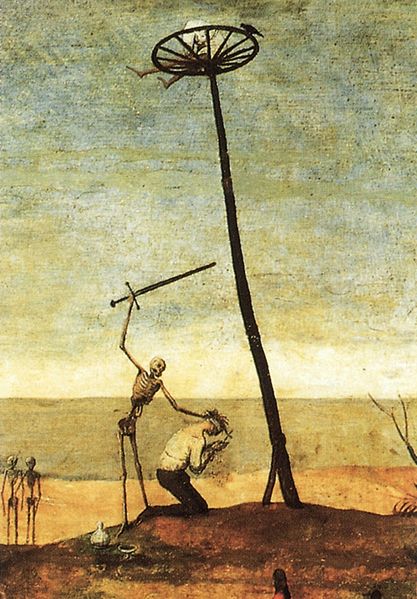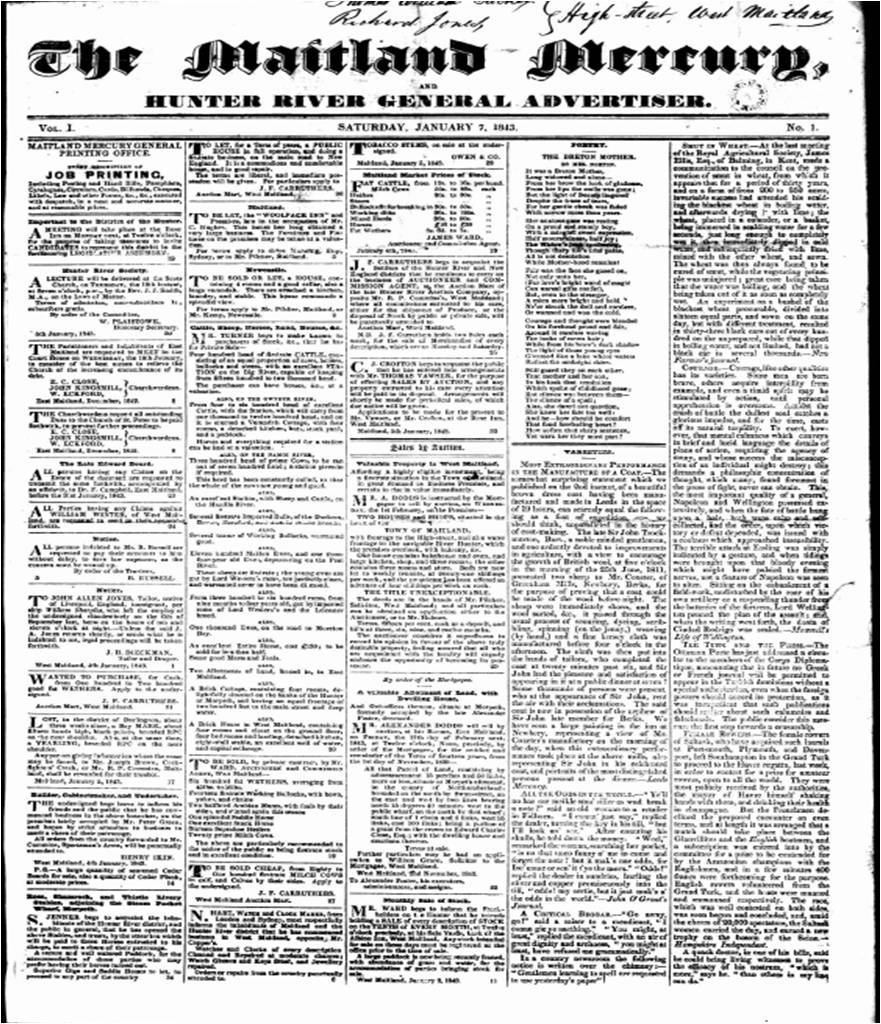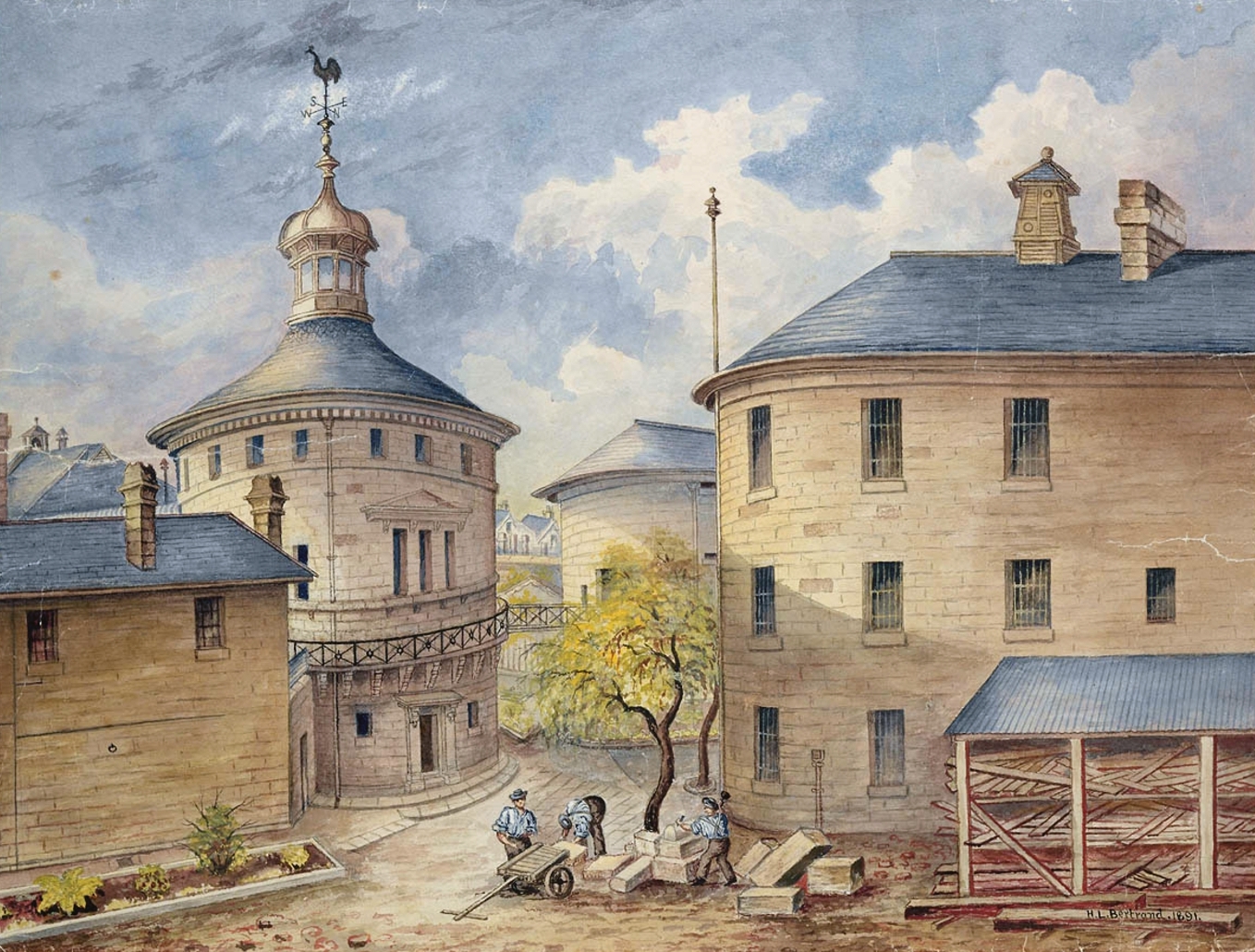|
Alexander Green (executioner)
Alexander Green (–1879) was an Australian executioner. He arrived in the colony of New South Wales in 1824 as a convict and became the colony's official executioner in 1828. His career as an executioner spanned over 25 years and carried out almost 500 executions, all but one of which were public. Early life Green was born in the Netherlands in about 1802, the son of a travelling circus performer. In 1824, he was convicted of theft at Shrewsbury for stealing "a piece of brown stuff from a shop" and sentenced to be transported to Australia. He was listed as working as a tumbler on the court record and was recorded as standing tall. Australia Green arrived in Sydney as a convict on 12 July 1824 aboard '' Countess of Harcourt''. He was initially lodged in the Hyde Park Barracks and worked for William Hutchison and Samuel Marsden under the system of convict assignment. He received a conditional pardon in May 1825 and his initial life sentence was commuted to a term of seven ye ... [...More Info...] [...Related Items...] OR: [Wikipedia] [Google] [Baidu] |
Executioner
An executioner, also known as a hangman or headsman, is an official who executes a sentence of capital punishment on a legally condemned person. Scope and job The executioner was usually presented with a warrant authorising or ordering him to ''execute'' the sentence. The warrant protects the executioner from the charge of murder. Common terms for executioners derived from forms of capital punishment—though they often also performed other physical punishments—include hangman (hanging) and headsman (beheading). In the military, the role of executioner was performed by a soldier, such as the ''provost''. A common stereotype of an executioner is a hooded medieval or absolutist executioner. Symbolic or real, executioners were rarely hooded, and not robed in all black; hoods were only used if an executioner's identity and anonymity were to be preserved from the public. As Hilary Mantel noted in her 2018 Reith Lectures, "Why would an executioner wear a mask? Everybody kne ... [...More Info...] [...Related Items...] OR: [Wikipedia] [Google] [Baidu] |
Richard Bourke
General Sir Richard Bourke, KCB (4 May 1777 – 12 August 1855), was an Irish-born British Army officer who served as Governor of New South Wales from 1831 to 1837. As a lifelong Whig (Liberal), he encouraged the emancipation of convicts and helped bring forward the ending of penal transportation to Australia. In this, he faced strong opposition from the landlord establishment and its press. He approved a new settlement on the Yarra River, and named it Melbourne, in honour of the incumbent British prime minister, Lord Melbourne. Early life and career Born in Dublin, Ireland, Bourke was educated at Westminster and read law at Christ Church, Oxford. He was a cousin of Edmund Burke and spent school and university holidays at Burke's home, and thus acquired some influential friends. He joined the British Army as an ensign in the Grenadier Guards on 22 November 1798, serving in the Netherlands with the Duke of York before a posting in South America in 1807, where he participated ... [...More Info...] [...Related Items...] OR: [Wikipedia] [Google] [Baidu] |
The Maitland Mercury And Hunter River General Advertiser
The ''Maitland Mercury'' is Australia's third oldest regional newspaper, preceded only by the ''Geelong Advertiser'' (estab. 1840) and the ''Launceston Examiner'' (estab. 1842). The ''Maitland Mercury'' was established in 1843 when it was called ''The Maitland Mercury and Hunter River General Advertiser''. ''The Maitland Mercury'' is still in circulation serving the city of Maitland and the surrounding Lower Hunter Valley. These days the Maitland Mercury has a weekly print edition which appears on Fridays. History It was originally a weekly newspaper, founded by Richard Jones, an English migrant from Liverpool who also served as treasurer of NSW for a brief period. The first issue was published as ''The Maitland Mercury and Hunter River General Advertiser'' on 7 January 1843. It has been a daily since 1894. when it was issued under two banners as ''The Maitland Daily Mercury'' during the week and ''The Maitland Weekly Mercury'' on Saturdays. From 1870 to 1873, Margaret Fall ... [...More Info...] [...Related Items...] OR: [Wikipedia] [Google] [Baidu] |
Freeman's Journal
The ''Freeman's Journal'', which was published continuously in Dublin from 1763 to 1924, was in the nineteenth century Ireland's leading nationalist newspaper. Patriot journal It was founded in 1763 by Charles Lucas and was identified with radical 18th-century Protestant patriot politicians Henry Grattan and Henry Flood. This changed from 1784 when it passed to Francis Higgins (better known as the "Sham Squire") and took a more pro-British and pro-administration view. In fact Francis Higgins is mentioned in the Secret Service Money Book as having betrayed Lord Edward FitzGerald. Higgins was paid £1,000 for information on FitzGerald's capture. Voice of constitutional nationalism In the 19th century it became more nationalist in tone, particularly under the control and inspiration of Sir John Gray (1815–75). ''The Journal'', as it was widely known as, was the leading newspaper in Ireland throughout the 19th century. Contemporary sources record it being read to the largely i ... [...More Info...] [...Related Items...] OR: [Wikipedia] [Google] [Baidu] |
Colonial Secretary Of New South Wales
Colonial or The Colonial may refer to: * Colonial, of, relating to, or characteristic of a colony or colony (biology) Architecture * American colonial architecture * French Colonial * Spanish Colonial architecture Automobiles * Colonial (1920 automobile), the first American automobile with four-wheel brakes * Colonial (Shaw automobile), a rebranded Shaw sold from 1921 until 1922 * Colonial (1921 automobile), a car from Boston which was sold from 1921 until 1922 Places * The Colonial (Indianapolis, Indiana) * The Colonial (Mansfield, Ohio), a National Register of Historic Places listing in Richland County, Ohio * Ciudad Colonial (Santo Domingo), a historic central neighborhood of Santo Domingo * Colonial Country Club (Memphis), a golf course in Tennessee * Colonial Country Club (Fort Worth), a golf course in Texas ** Fort Worth Invitational or The Colonial, a PGA golf tournament Trains * ''Colonial'' (PRR train), a Pennsylvania Railroad run between Washington, DC and ... [...More Info...] [...Related Items...] OR: [Wikipedia] [Google] [Baidu] |
Edward Deas Thomson
Sir Edward Deas Thomson (1 June 1800 – 16 July 1879) was a Scotsman who became an administrator and politician in Australia, and was chancellor of the University of Sydney. Background and early career Thomson was born at Edinburgh, Scotland. His father, Sir John Deas Thomson, was accountant-general to the navy and married Rebecca, daughter of John Freer. Their son was educated at Edinburgh high school, and at Harrow in England. He afterwards spent two years in study at Caen in Normandy, France. His tutor there, from September 1815, was Joseph Lowe. Thomson then began working with his father who at that time was reorganizing the system of keeping accounts in the navy. In 1826 Thomson visited the United States and Canada, and on his return in 1827 accepted the position of registrar of the orphan chambers at Demarara. Before leaving England he was able to arrange to exchange this position for that of clerk to the New South Wales legislative and executive councils. In Australi ... [...More Info...] [...Related Items...] OR: [Wikipedia] [Google] [Baidu] |
Gladesville Mental Hospital
The Gladesville Mental Hospital, formerly known as the Tarban Creek Lunatic Asylum, was a psychiatric hospital established in 1838 in the Sydney suburb of Gladesville. The hospital officially closed in 1993, with the last inpatient services ceasing in 1997. Description and history Before 1838, people with mental or emotional problems in the Sydney area were housed in a "lunatic asylum" in Gladesville, a suburb located on the Parramatta River's Northern banks between Sydney and Parramatta, or in the Female Factory at Parramatta, twenty-four kilometres west of Sydney. In the 1830s, construction of a purpose-built asylum began on the banks of the Parramatta River, in the area now known as Gladesville. The original sandstone complex, known initially as Tarban Creek Lunatic Asylum, was designed by the Colonial Architect, Mortimer Lewis, between 1836 and 1838. Patients were then transferred from Liverpool and the Female Factory. James Barnet designed additional buildings in ... [...More Info...] [...Related Items...] OR: [Wikipedia] [Google] [Baidu] |
Darlinghurst Gaol
The Darlinghurst Gaol is a former Australian prison located in Darlinghurst, New South Wales. The site is bordered by Darlinghurst Road, Burton and Forbes streets, with entrances on Forbes and Burton Streets. The heritage-listed building, predominantly designed by New South Wales Colonial Architect Mortimer Lewis, was closed in 1914 and has subsequently been repurposed to house the National Art School. History Construction commenced with pegging out by Francis Greenway in 1821. The Darlinghurst Gaol wall began in 1822 and finished in 1824 using convict labour, but due to a lack of funds, the site sat empty for 12 years. Construction of the rest of the complex did not begin until 1836, with completion of some of the cell blocks in 1840. The gaol was ready for occupation a year later, with the first prisoners occupying the gaol on 7 June 1841. The gaol was finally completed in 1885. The main material used for construction of the gaol is Sydney sandstone, cut into large blocks ... [...More Info...] [...Related Items...] OR: [Wikipedia] [Google] [Baidu] |
Dundalli
Dundalli (c. 1820 – 5 January 1855) was an Aboriginal lawman who figured prominently in accounts of conflict between European settlers and indigenous aboriginal peoples in the area of Brisbane in South East Queensland. Traditionally described as a murderer, savage and terrorist, he is now thought variously to have been a guerilla leader or to have coordinated a decade-long resistance to white colonization the area. He was hanged publicly in Brisbane in 1855 by order of the Sheriff of New South Wales. Early life Dundalli was born into the Dalla tribes, probably as a son of the Dalambara clan. Together with his brother Oumulli, he grew up in the Blackall Range. The area had a rich regional economy, with fertile ranges spread out over areas of spectacular scenery, with waterfalls plunging into deep gorges. These uplands of the Glass House Mountains and the D'Aguilar, Conondale and Jimna ranges were the homelands of the Dalla, who spoke a language closely related tKabi Kabi ... [...More Info...] [...Related Items...] OR: [Wikipedia] [Google] [Baidu] |
John Knatchbull (Royal Navy Captain)
John Graham Knatchbull (bapt. 24 January 1793 – 13 February 1844) was an English naval captain and convict found guilty of murder in 1844. He was one of the earliest to raise in a British court the plea of moral insanity (unsuccessfully). Biography Knatchbull was born in Mersham, Kent, England, likely the son of Sir Edward Knatchbull, 8th Baronet Sir Edward Knatchbull, 8th Baronet (22 May 1758 – 1 September 1819) was a British politician and baronet. Background He was the only surviving son of Sir Edward Knatchbull, 7th Baronet and his wife Grace Legge, second daughter of William Legge ... of Mersham Hatch, and his second wife, Frances Graham. His father had 20 children by three wives. He attended Winchester College and volunteered for the navy in 1804 serving until 1818 and rising to the rank of Captain. He served aboard the HMS Ardent (1796), ''Ardent'', HMS Revenge (1805), ''Revenge'', HMS Zealand, ''Zealand'', French frigate Sibylle (1791), ''Sybille'', HMS Te ... [...More Info...] [...Related Items...] OR: [Wikipedia] [Google] [Baidu] |
Myall Creek Massacre
The Myall Creek massacre was the killing of at least twenty-eight unarmed Indigenous Australians by twelve colonists on 10 June 1838 at the Myall Creek near the Gwydir River, in northern New South Wales. After two trials, seven of the twelve colonists were found guilty of murder and hanged, a verdict which sparked extreme controversy within New South Wales settler society. One—the leader and free settler John Fleming—evaded arrest and was never tried. Four were never retried following the not guilty verdict of the first trial. Description of the massacre A group of eleven stockmen, consisting of assigned convicts and former convicts, ten of them white Europeans, the 11th, John Johnstone, a black African, led by John Henry Fleming, who was from ''Mungie Bundie Run'' near Moree, arrived at Henry Dangar's Myall Creek station in New England on 9 June 1838. They rode up to the station huts beside which were camped a group of approximately thirty-five Aboriginal people. They ... [...More Info...] [...Related Items...] OR: [Wikipedia] [Google] [Baidu] |
Norfolk Island
Norfolk Island (, ; Norfuk: ''Norf'k Ailen'') is an external territory of Australia located in the Pacific Ocean between New Zealand and New Caledonia, directly east of Australia's Evans Head and about from Lord Howe Island. Together with the neighbouring Phillip Island and Nepean Island, the three islands collectively form the Territory of Norfolk Island. At the 2021 census, it had inhabitants living on a total area of about . Its capital is Kingston. The first known settlers in Norfolk Island were East Polynesians but they had already departed when Great Britain settled it as part of its 1788 settlement of Australia. The island served as a convict penal settlement from 6 March 1788 until 5 May 1855, except for an 11-year hiatus between 15 February 1814 and 6 June 1825, when it lay abandoned. On 8 June 1856, permanent civilian residence on the island began when descendants of the ''Bounty'' mutineers were relocated from Pitcairn Island. In 1914 the UK handed Nor ... [...More Info...] [...Related Items...] OR: [Wikipedia] [Google] [Baidu] |




